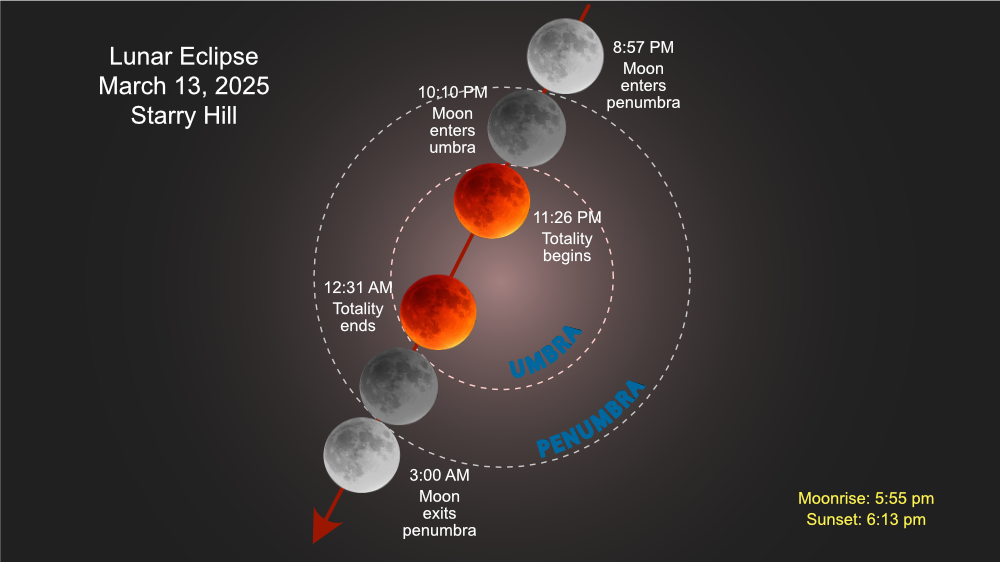| 2025 March 13: Total Lunar Eclipse (2025-2-01) ⬅︎ |
 |
Eclipses happen when the Sun, Earth, and Moon play a cosmic game of tag. About every six months, during eclipse seasons, these celestial bodies align just right, and we get to witness solar and lunar eclipses from different parts of Earth.
In 2025, eclipse seasons will occur in March and September. Each month will bring both a lunar eclipse and a solar eclipse. So, will folks in the Starry Hill region (the Pacific Northwest) be able to catch a glimpse of these celestial wonders? Yes, we’ll be able to see a total lunar eclipse on the evening of March 13th.
Now, let’s talk about what a lunar eclipse is. Picture this: the Sun’s light hits the Earth, creating a cone-shaped shadow that stretches almost a million miles into space. A lunar eclipse happens when the Moon moves into this shadow.
But there’s more! There are two parts to the Earth’s shadow: the penumbra (almost shadow in Latin) and the umbra (shadow in Latin, like the word umbrella). When the Moon enters the penumbra, it turns a dark gray. But when it dives into the umbra, things get interesting! The Moon turns a deep red color. Why red? Well, it’s all thanks to the light from the Sun skimming through the Earth’s atmosphere. This light gets turned red, and it’s like a projection of all Earth’s sunrises and sunsets onto the Moon. That’s why the Moon is sometimes called a ‘blood moon’ when it’s in the umbra.
Mark your calendars! On the evening of March 13th, we’ll be treated to a total lunar eclipse. The eclipse starts right before 9 PM, and it’s going to be a sight to behold!
Here are the key events to look out for:
* 8:57 PM: The Moon enters the penumbra and starts to darken. The eclipse has begun!
* 10:10 PM: The Moon enters the umbra and turns a deep red.
* 11:26 PM: Totality starts - the Moon is totally red!
* 12:31 AM: Totality ends - the Moon is no longer totally red.
* 1:48 AM: The Moon exits the umbra and is dark but no longer red.
* 3:00 AM: The Moon exits the penumbra, and the eclipse is over.
So, grab some snacks, find a spot with a clear view, and let’s witness this celestial spectacle together!
2025 MAR 14 UPDATE
While is was overcast all day, the clouds opened up right before midnight allowing us to take in the eclipse. The moon was lovely and yes, we took some pics. Here's one:
Clear skies!
|
| |



